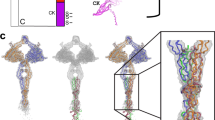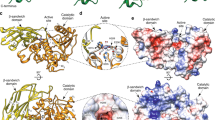Abstract
The gel-forming mucins are large and heavily O-glycosylated proteins which build up mucus gels. The recombinant production of full-length gel-forming mucins has not been possible to date. In order to study mucin biosynthesis and biochemistry, we and others have taken the alternative approach of constructing different recombinant proteins consisting of one or several domains of these large proteins and expressing them separately in different cell lines. Using this approach, we have determined that MUC2, the intestinal gel-forming mucin, dimerizes via its C-terminal cysteine-knot domain and also trimerizes via one of the N-terminal von Willebrand D domains. Both of these interactions are disulfide bond mediated. Via this assembly, a molecular network is built by which the mucus gel is formed. Here we discuss not only the functional understanding obtained from studies of the recombinant proteins, but also highlight the difficulties encountered when these proteins were produced recombinantly. We often found an accumulation of the proteins in the ER and consequently no secretion. This was especially apparent when the cysteine-rich domains of the N- and C-terminal parts of the mucins were expressed. Other proteins that we constructed were either not secreted or not expressed at all. Despite these problems, the knowledge of mucin biosynthesis and assembly has advanced considerably through the studies of these recombinant proteins.



Similar content being viewed by others
References
Lang, T., Hansson, G. C., & Samuelsson, T. (2007). Gel-forming mucins appeared early in metazoan evolution. Proceedings of the National Academy of Sciences of the United States of America, 104, 16209–16214.
Thornton, D. J., Rousseau, K., & McGuckin, M. A. (2008). Structure and function of the polymeric mucins in airways mucus. Annual Review of Physiology, 70, 459–486.
Johansson, M. E., Ambort, D., Pelaseyed, T., Schutte, A., Gustafsson, J. K., et al. (2011). Composition and functional role of the mucus layers in the intestine. Cellular and Molecular Life Sciences, 68, 3635–3641.
Andersch-Björkman, Y., Thomsson, K. A., Holmen Larsson, J. M., Ekerhovd, E., & Hansson, G. C. (2007). Large scale identification of proteins, mucins, and their O-glycosylation in the endocervical mucus during the menstrual cycle. Molecular and Cellular Proteomics, 6, 708–716.
Zhu, L., Lee, P., Yu, D., Tao, S., & Chen, Y. (2011). Cloning and characterization of human MUC19 gene. American Journal of Respiratory Cell and Molecular Biology, 45, 348–358.
Burchell, J. M., Mungul, A., & Taylor-Papadimitriou, J. (2001). O-linked glycosylation in the mammary gland: changes that occur during malignancy. Journal Mammary Gland Biol Neoplasia, 6, 355–364.
Müller, S., & Hanisch, F. G. (2002). Recombinant MUC1 probe authentically reflects cell-specific O-glycosylation profiles of endogenous breast cancer mucin. High density and prevalent core 2-based glycosylation. Journal of Biological Chemistry, 277, 26103–26112.
Bäckström, M., Link, T., Olson, F. J., Karlsson, H., Graham, R., et al. (2003). Recombinant MUC1 mucin with a breast cancer-like O-glycosylation produced in large amounts in Chinese-hamster ovary cells. The Biochemical Journal, 376, 677–686.
Premaratne, P., Welen, K., Damber, J. E., Hansson, G. C., & Bäckström, M. (2011). O-glycosylation of MUC1 mucin in prostate cancer and the effects of its expression on tumor growth in a prostate cancer xenograft model. Tumour Biology, 32, 203–213.
Sihlbom, C., van Dijk-Härd, I., Lidell, M. E., Noll, T., Hansson, G. C., et al. (2009). Localization of O-glycans in MUC1 glycoproteins using electron-capture dissociation fragmentation mass spectrometry. Glycobiology, 19, 375–381.
Sewell, R., Bäckström, M., Dalziel, M., Gschmeissner, S., Karlsson, H., et al. (2006). The ST6GalNAc-I sialyltransferase localizes throughout the Golgi and is responsible for the synthesis of the tumor-associated sialyl-Tn O-glycan in human breast cancer. Journal of Biological Chemistry, 281, 3586–3594.
Domino, S. E., Hurd, E. A., Thomsson, K. A., Karnak, D. M., Holmen Larsson, J. M., et al. (2009). Cervical mucins carry alpha(1,2)fucosylated glycans that partly protect from experimental vaginal candidiasis. Glycoconjugate Journal, 26, 1125–1134.
Park, S. W., Zhen, G., Verhaeghe, C., Nakagami, Y., Nguyenvu, L. T., et al. (2009). The protein disulfide isomerase AGR2 is essential for production of intestinal mucus. Proceedings of the National Academy of Sciences of the United States of America, 106, 6950–6955.
Lidell, M. E., Johansson, M. E., Mörgelin, M., Asker, N., Gum, J. R., Jr, et al. (2003). The recombinant C-terminus of the human MUC2 mucin forms dimers in Chinese-hamster ovary cells and heterodimers with full-length MUC2 in LS 174T cells. The Biochemical Journal, 372, 335–345.
Lidell, M. E., & Hansson, G. C. (2006). Cleavage in the GDPH sequence of the C-terminal cysteine-rich part of the human MUC5AC mucin. The Biochemical Journal, 399, 121–129.
Bell, S. L., Khatri, I. A., Xu, G., & Forstner, J. F. (1998). Evidence that a peptide corresponding to the rat Muc2 C-terminus undergoes disulphide-mediated dimerization. European Journal of Biochemistry, 253, 123–131.
Bell, S. L., Xu, G., & Forstner, J. F. (2001). Role of the cystine-knot motif at the C-terminus of rat mucin protein Muc2 in dimer formation and secretion. The Biochemical Journal, 357, 203–209.
Perez-Vilar, J., & Hill, R. L. (1998). The carboxyl-terminal 90 residues of porcine submaxillary mucin are sufficient for forming disulfide-bonded dimers. Journal of Biological Chemistry, 273, 6982–6988.
Leir, S. H., & Harris, A. (2011). MUC6 mucin expression inhibits tumor cell invasion. Experimental cell research, 317, 2408–2419.
Lidell, M. E., Johansson, M. E., & Hansson, G. C. (2003). An autocatalytic cleavage in the C terminus of the human MUC2 mucin occurs at the low pH of the late secretory pathway. Journal of Biological Chemistry, 278, 13944–13951.
Godl, K., Johansson, M. E., Lidell, M. E., Mörgelin, M., Karlsson, H., et al. (2002). The N terminus of the MUC2 mucin forms trimers that are held together within a trypsin-resistant core fragment. Journal of Biological Chemistry, 277, 47248–47256.
Purvis, A. R., Gross, J., Dang, L. T., Huang, R. H., Kapadia, M., et al. (2007). Two Cys residues essential for von Willebrand factor multimer assembly in the Golgi. Proceedings of the National Academy of Sciences of the United States of America, 104, 15647–15652.
Perez-Vilar, J., Eckhardt, A. E., DeLuca, A., & Hill, R. L. (1998). Porcine submaxillary mucin forms disulfide-linked multimers through its amino-terminal D-domains. Journal of Biological Chemistry, 273, 14442–14449.
Ambort, D., van der Post, S., Johansson, M. E., Mackenzie, J., Thomsson, E., et al. (2011). Function of the CysD domain of the gel-forming MUC2 mucin. The Biochemical Journal, 436, 61–70.
Perez-Vilar, J., Randell, S. H., & Boucher, R. C. (2004). C-Mannosylation of MUC5AC and MUC5B Cys subdomains. Glycobiology, 14, 325–337.
Krieg, J., Glasner, W., Vicentini, A., Doucey, M. A., Loffler, A., et al. (1997). C-Mannosylation of human RNase 2 is an intracellular process performed by a variety of cultured cells. Journal of Biological Chemistry, 272, 26687–26692.
Acknowledgments
This work was supported by the Swedish Research Council (no. 7461, 21027, and 342-2004-4434), The Swedish Cancer Foundation, The Knut and Alice Wallenberg Foundation (KAW2007.0118), IngaBritt and Arne Lundberg Foundation, Sahlgren’s University Hospital (LUA-ALF), Wilhelm and Martina Lundgren’s Foundation, Torsten och Ragnar Söderbergs Stiftelser, The Sahlgrenska Academy and The Swedish Foundation for Strategic Research—The Mucus–Bacteria–Colitis Center (MBC) of the Innate Immunity Program. Parts of the work were performed at the Mammalian Protein Expression Core Facility at the University of Gothenburg.
Author information
Authors and Affiliations
Corresponding author
Rights and permissions
About this article
Cite this article
Bäckström, M., Ambort, D., Thomsson, E. et al. Increased Understanding of the Biochemistry and Biosynthesis of MUC2 and Other Gel-Forming Mucins Through the Recombinant Expression of Their Protein Domains. Mol Biotechnol 54, 250–256 (2013). https://doi.org/10.1007/s12033-012-9562-3
Published:
Issue Date:
DOI: https://doi.org/10.1007/s12033-012-9562-3




